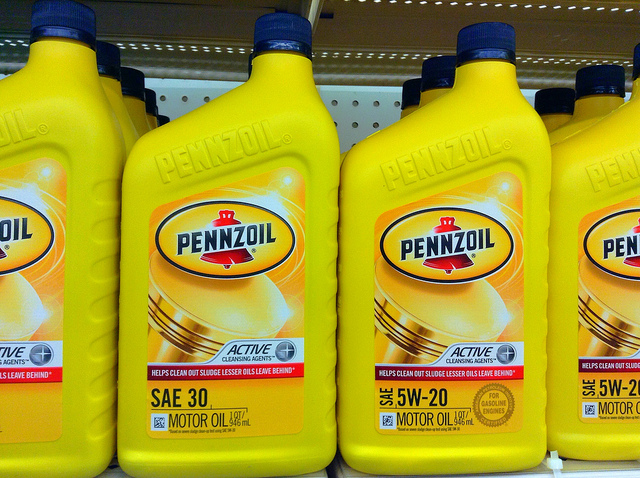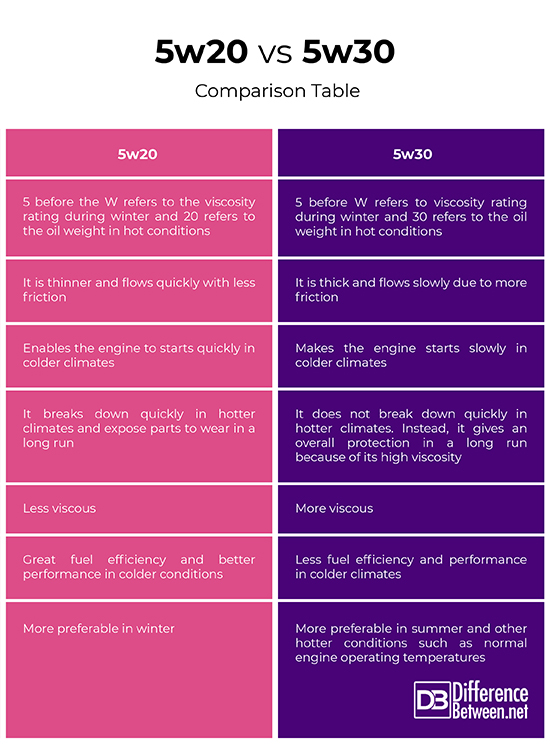Difference Between 5w20 and 5w30
5w20 and 5w30 are the two most common engine oil types used in vehicles. There is a confusion in the understanding of these oil types to an extent where others use them interchangeably. There is, however, a significant difference in the oil types which is mainly attributed to their viscosity – that is, the ability to flow or the thickness of the oil to flow against friction.
Given this difference in viscosities, these oil types are best suited for use in different conditions. The article unfolds the key differences between 5w20 and 5w30.

What is 5w20?
5w20 is common engine oil type well suited to colder climates. The number before the “W” refers to the viscosity rating of the oil in winter (W), whereas the number “20” after “W” is a reference to a 20 weight oil in warmer temperatures. In other words, 5w20 lubricates the engine like a 20 weight oil. 5w20 works well during low and freezing temperatures as it experiences less friction and drag to flow to deeper engine components because it is thinner. The higher the number the higher the viscosity hence 5w20 flows more freely than the 5w30.
When starting the engine in colder climates, it requires a thinner oil that can lubricate the parts quickly. Because of its less viscosity, 5w20 is linked to an optimal fuel efficiency and performance in cold climates. However, when the engine heats to normal operating temperatures, 5w20 start to lack the viscosity required to protect the engine parts over a long time hence 5w30 is more preferable. 5w20 will, instead, breakdown easily in hotter climates and thus expose engine parts to wear. At 100 degrees Celsius, the viscosity of 5w20 is rated at 8.9 and that of 5w30 is rated at 11.0. And at 40 degrees Celsius, 5w20 is rated at 49.8 and that of 5w30 is rated at 61.7. This shows the effect of heat on viscosities of engine oils.

What is 5w30?
5w30 is renowned as the best engine oil at warmer temperatures when compared with the 5w20. It is the oil type characterized by higher viscosity – that is, its thickness. It experiences lots of friction and more drag when flowing. As a result, it takes time to lubricate the engine parts in colder climates. An engine running on 5w30 may experience delays to start during winter. It may, moreover, experience hiccups. A thicker engine oil is not preferred during colder climates because of its inability to flow readily and quickly to all engine components in a short period of time. As a result, fuel efficiency will be compromised.
When the engine has heated to normal operating temperatures or the vehicle is driven in hotter environments, the 5w30 is a preferred engine oil type. This is due to its thickness which gives the overall protection to engine parts and a better performance. Its counterpart 5w20 would breakdown in summer temperatures. The meaning of the formula XwY in 5w30 is the same as with the 5w20. The 5 before the “W” refers to the viscosity rating in winter and the 30 refers to its lubrication as compared to a 30 weight oil in warmer conditions. The higher the number the higher the viscosity hence 5w30 is thicker than the 5w20.
Both engine oils, 5w20 and 5w30, have the same design of viscosity during winter but differs with the weight during warmer temperatures. 5w20, despite the same design of viscosity, thins out more given less friction in the engine components. There is not necessarily a clear winner between these engine oils as they perform better in different climates. In a long run, 5w30 tends to have more benefits as it gives an overall protection versus slower startups in colder climates. 5w20, on the other hand, would expose the engine parts to wear as it breakdown quickly due to its thinness in hotter climates.
Key difference between 5w20 and 5w30
Definition of 5w20 Vs. 5w30
5w20 is an engine oil type characterized by its winter rating of 5 and an oil weight of 20 in warmer conditions. It is less viscous compared to 5w30. 5w30 has the same viscosity rating of 5 during winter but an oil weight of 30 during hotter conditions hence it is thicker.
Working conditions for 5w20 Vs. 5w30
5w20 works well in colder climates. It enables the vehicle engine to start quickly as it flows quickly and smoothly to deeper engine components with less friction. It lubricates the parts quickly. 5w30, on the other hand, is working efficiently in hotter climates. It does not thin out quickly due to an exposure to heat compared to 5w20. As a result, 5w30 gives a better overall protection to the engine components in normal operating temperatures.
Performance of 5w20 Vs. 5w30
These two engine oils perform efficiently in their designed climates. 5w20 is a champion in colder climates with quicker engine startups because of its low viscosity and less friction in the engine parts. 5w30 is also a champion in hotter climates where a thick oil is needed to withstand the higher temperatures. The engine will inevitably get hotter and thus requires a more viscous oil. In colder climates, 5w20 is linked with fuel efficiency and better performance while 5w30 is linked with a better overall protection of the engine components.
5w20 Vs. 5w30: Comparison Table

Summary of 5w20 Vs. 5w30
- 5w20 is less viscous while 5w30 is more viscous
- 5w20 is more preferable in winter where it flows readily and quickly to lubricate the engine parts so the engine starts quickly
- 5w30 is thick to flow quickly during winter climates to start the engine faster. The colder the temperature the more viscous the liquid is.
- 5w20 thins out quickly in hotter conditions so it is not preferable in hotter climates. 5w30, on the other hand, remains thicker than the 5w20 in hotter temperatures.
- Difference Between CBD and Indica - April 22, 2019
- Difference Between Unilateral Contract and Bilateral Contract - February 8, 2019
- Difference Between Polki and Kundan - December 15, 2018
Search DifferenceBetween.net :
 Email This Post
: If you like this article or our site. Please spread the word. Share it with your friends/family.
Email This Post
: If you like this article or our site. Please spread the word. Share it with your friends/family.
2 Comments
Leave a Response
References :
[0]James A. Spearot, (1989). High-temperature, High-shear (HTHS) Oil Viscosity: Measurement and Relationship to Engine Operation, Issue 1068. ASTM International
[1]S. P. Srivastava (11 Jul 2014). Developments in Lubricant Technology. John Wiley & Sons
[2]Image credit: https://www.flickr.com/photos/jeepersmedia/14865794155
[3]Image credit: https://media.defense.gov/2012/Jan/18/2000185824/780/780/0/120111-F-GE255-080.JPG


I have a 2012 Hyundai Elantra and the recommended oil is 5w20 but am in Ghana where the temperature is always hot so can I use 5w30.
Yes, for sure.